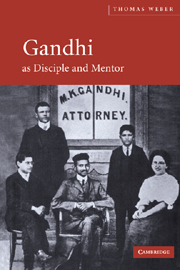Book contents
- Frontmatter
- Contents
- Notes
- Preface
- Glossary
- PART I INFLUENCE
- PART II GANDHI INFLUENCED
- PART III GANDHI'S INFLUENCE
- 8 The influential Gandhi
- 9 Arne Næss – the ecological movement finds depth
- 10 Johan Galtung – peace research moves beyond war
- 11 E. F. Schumacher – economics as if people mattered
- 12 Gene Sharp – nonviolence becomes a political method
- 13 The bottom of the hourglass: Gandhi's influence
- Bibliography
- Index
13 - The bottom of the hourglass: Gandhi's influence
Published online by Cambridge University Press: 22 September 2009
- Frontmatter
- Contents
- Notes
- Preface
- Glossary
- PART I INFLUENCE
- PART II GANDHI INFLUENCED
- PART III GANDHI'S INFLUENCE
- 8 The influential Gandhi
- 9 Arne Næss – the ecological movement finds depth
- 10 Johan Galtung – peace research moves beyond war
- 11 E. F. Schumacher – economics as if people mattered
- 12 Gene Sharp – nonviolence becomes a political method
- 13 The bottom of the hourglass: Gandhi's influence
- Bibliography
- Index
Summary
GANDHI AND HIS DISCIPLES
For many westerners, and increasingly Indians as well, Gandhism stopped with the Mahatma. Jayaprakash Narayan and Vinoba Bhave are unknown or distantly remembered as Gandhi-following politicians or social reformers. Although many of the Mahatma's leading co-workers wrote autobiographies, or had biographies written about them, and Vinoba Bhave's Bhoodan movement and Jayaprakash Narayan's Total Revolution have received considerable attention, especially by Indian scholars, books about, and studies of, the rest of the Gandhi-inspired post-Gandhians have been rare.
In 1977, highly successful books by Ved Mehta and V. S. Naipaul appeared in which Gandhi and his disciples were portrayed in most unsympathetic ways. Ten years later, American writer Mark Shepard produced an uplifting book on Gandhi's disciples. In this book, Gandhi Today, Shepard asked the question about the status of the Gandhian tradition in India, whether it had died away, and what had become of the constructive workers that Gandhi sent to the villages. He concluded that with the passing of Vinoba and JP, ‘it is unlikely that the Sarvodaya Movement will again be a major force on a national level’. He noted, however, that there are still Gandhians who are a ‘vital force’ in the communities they have settled in, and it is ‘in these enclaves … that the main strength of the Sarvodaya Movement is found today.
- Type
- Chapter
- Information
- Gandhi as Disciple and Mentor , pp. 247 - 254Publisher: Cambridge University PressPrint publication year: 2004

